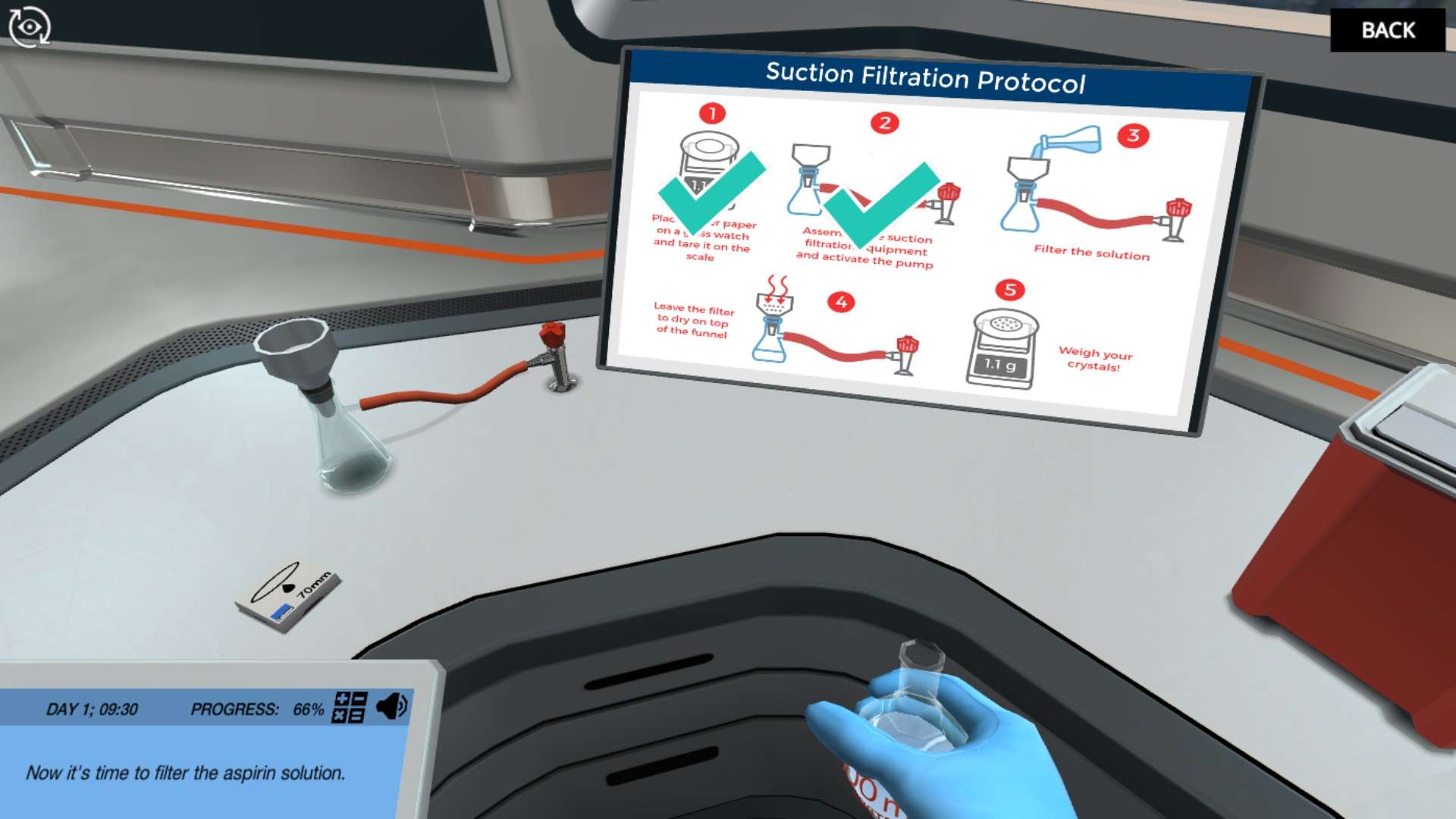Heading 1
Heading 2
Heading 3
Heading 4
Heading 5
Heading 6
Lorem ipsum dolor sit amet, consectetur adipiscing elit, sed do eiusmod tempor incididunt ut labore et dolore magna aliqua. Ut enim ad minim veniam, quis nostrud exercitation ullamco laboris nisi ut aliquip ex ea commodo consequat. Duis aute irure dolor in reprehenderit in voluptate velit esse cillum dolore eu fugiat nulla pariatur.
Block quote
Ordered list
- Item 1
- Item 2
- Item 3
Unordered list
- Item A
- Item B
- Item C
Bold text
Emphasis
Superscript
Subscript
About This Simulation
Hone your synthetic skills in organic chemistry by going through a reaction that involves crystallization, filtration, calculation of the yield and a quality analysis using the melting point: the synthesis of aspirin.
Learning Objectives
- Briefly describe the reactions involved in the synthesis procedure (esterification)
- Correctly assemble and use condenser apparatus
- Correctly assemble and use the suction filtration (Buchner)
- Determine the percentage yield of the final product
- Assess the purity with the melting point technique
About This Simulation
Lab Techniques
- Organic synthesis
- Percentage yield calculation
Related Standards
- Early Stage Bachelors Level
- EHEA First Cycle
- EHEA Short Cycle
- FHEQ 6
- SCQF 10
- SCQF 9
- US College Year 1
- US College Year 2
- US College Year 3
- Chemistry D.2
Learn More About This Simulation
Begin your learning experience in a modern pharmacy and help Marie the pharmacist, by synthetizing some extra aspirin in the laboratory, to fight the outbreak of headaches amongst students during the exam period.
Identify the reaction
First, let’s dive into the theory! Learn about esterification reactions and the history of aspirin. You will be challenged to understand the correct reagents and products involved in the synthesis of aspirin. With the basics now covered, you are ready to step into the laboratory!
Perform crystallization and filtration
The practical part of the simulation begins. Following the canonical synthetic route, you go through the steps of a synthesis like you would in a real laboratory, with some precious time gained! In our virtual lab, multiple actions can happen simultaneously and you can speed up time.
From weighing the reagent to setting the correct apparatus for the reaction, from finding the correct ways of cooling down a solution to following the best practices to form big crystals, you are constantly challenged and supported with the theory. A great way to learn by doing, gain lab skills and master the equipment!
Calculate the yield and check the quality of the product
To complete the experience, you are asked to look into which steps could have caused a loss of product in the whole synthetic process, and calculate the yield. You are also responsible for testing the quality of the product, and perform a qualitative analysis using the melting point technique.
Time to check if your mission is accomplished! Did you synthetize enough aspirin to help all those students?
For Science Programs Providing a Learning Advantage
Boost STEM Pass Rates
Boost Learning with Fun
75% of students show high engagement and improved grades with Labster
Discover Simulations That Match Your Syllabus
Easily bolster your learning objectives with relevant, interactive content
Place Students in the Shoes of Real Scientists
Practice a lab procedure or visualize theory through narrative-driven scenarios


FAQs
Find answers to frequently asked questions.
Heading 1
Heading 2
Heading 3
Heading 4
Heading 5
Heading 6
Lorem ipsum dolor sit amet, consectetur adipiscing elit, sed do eiusmod tempor incididunt ut labore et dolore magna aliqua. Ut enim ad minim veniam, quis nostrud exercitation ullamco laboris nisi ut aliquip ex ea commodo consequat. Duis aute irure dolor in reprehenderit in voluptate velit esse cillum dolore eu fugiat nulla pariatur.
Block quote
Ordered list
- Item 1
- Item 2
- Item 3
Unordered list
- Item A
- Item B
- Item C
Bold text
Emphasis
Superscript
Subscript
A Labster virtual lab is an interactive, multimedia assignment that students access right from their computers. Many Labster virtual labs prepare students for success in college by introducing foundational knowledge using multimedia visualizations that make it easier to understand complex concepts. Other Labster virtual labs prepare learners for careers in STEM labs by giving them realistic practice on lab techniques and procedures.
Labster’s virtual lab simulations are created by scientists and designed to maximize engagement and interactivity. Unlike watching a video or reading a textbook, Labster virtual labs are interactive. To make progress, students must think critically and solve a real-world problem. We believe that learning by doing makes STEM stick.
Yes, Labster is compatible with all major LMS (Learning Management Systems) including Blackboard, Canvas, D2L, Moodle, and many others. Students can access Labster like any other assignment. If your institution does not choose an LMS integration, students will log into Labster’s Course Manager once they have an account created. Your institution will decide which is the best access method.
Labster is available for purchase by instructors, faculty, and administrators at education institutions. Purchasing our starter package, Labster Explorer, can be done using a credit card if you are located in the USA, Canada, or Mexico. If you are outside of North America or are choosing a higher plan, please speak with a Labster sales representative. Compare plans.
Labster supports a wide range of STEM courses at the high school, college, and university level across fields in biology, chemistry, physics, and health sciences. You can identify topics for your courses by searching our Content Catalog.















